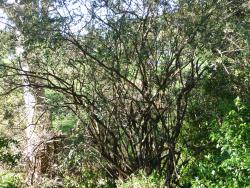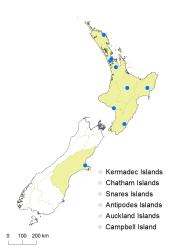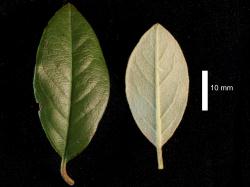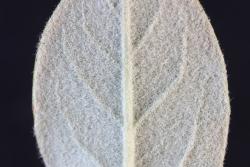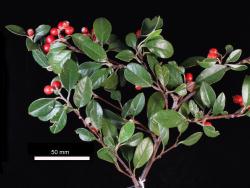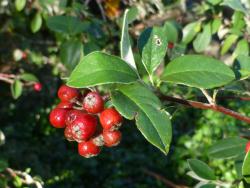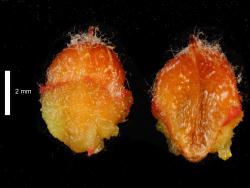Erect shrub to small tree 2–10 m tall, evergreen. Branches arched, spreading; branchlets red-brown to yellow-brown, cuticle peeling, papillae from old hair bases present, branchlet hairs dense in young branchlets, sparse in old branchlets, white to yellow; stipule 2.0–4.0 mm long, red, stipule hairs moderately dense, yellow. Leaves crowded on branches, 27–48 mm long, lamina (14)16–35(48) mm long, (9)12–19(24) mm wide, elliptic to obovate, slightly V-shaped at leaf base, otherwise plane, 200–260 µm thick, petiole 4–12 mm long, hairs on petiole dense and yellow in young leaves, becoming sparse; leaf base cuneate; leaf apex acute to obtuse, apiculus straight or bent downwards; lateral veins in 6–7 pairs, midvein only, or midvein and lateral veins impressed above and projecting below; upper surface smooth, moderate yellowish-green (RHS 139B), glossy, upper-surface hairs sparse to none, white; margins very slightly recurved or plane, hairs on margins dense and white in young leaves, not persisting; lower surface not visible due to dense, white tomentum in young and old leaves, tomentum becoming dirty in old leaves.
Inflorescence a corymb of 1–32 flowers, 12–65 mm long with 3 leaves, rachis hairs dense, off-white; pedicel 1.2–7 mm long, hairs dense, off-white. Flowers 8.0–9.0 mm diameter. Hypanthium green, sepals 1.6–2.0 mm long, 1.9–2.0 mm wide, hairs densely woolly, white. Petals spreading and white when open, 2.8–3.2 mm long, 2.3–3.1 mm wide, base not clawed, tuft of hairs usually present, small, margins slightly irregular, not papillose. Stamens 16–22; filaments 2.4–3.0 mm long, white; anthers red-purple, 0.8–1.0 mm long; styles 2, 2.6–2.9 mm long. Fruit vivid red (RHS 45A), oblong-obovate, 7.8–8.0 mm long, 5.5–8.0 mm diameter, calyx half-open, pyrenes visible, hairs persisting at calyx, sparse elsewhere on fruit skin, not persisting. Pyrenes invariably 2, 4.9–5.5 mm long, 3.2–3.9 mm wide, hairs moderately dense at apex, apex acute, style attached at pyrene apex.
An upright shrub to tree with medium-sized evergreen leaves that are densely and persistently tomentose on the lower surface such that the glaucous undersurface is not visible. Flowers have white spreading petals and two styles. Fruit have 2 pyrenes with the style at the pyrene apex.
Most similar to Cotoneaster franchetii. Both are erect shrubs with medium-sized leaves [C. pannosus lamina (14)16–35(48) × (9)12–19(24) mm; C. franchetii lamina 19–36(46) × 13–22 mm] that are elliptic or ovate and acute at the apex. Mean lamina length in C. pannosus is slightly less, 25.6 mm, than for C. franchetii with a mean of 29.4 mm. The difference in length is statistically significant (CI = 95%, 30 samples of each), but the size difference is too small to be useful.
Dickoré & Kasperek (2010) point out that herbarium specimens of this species are difficult to distinguish from those of C. franchetii despite the two being placed in different subgenera. Both have a dense felt of woolly hairs on the underside of the leaf, which persist with leaf age. Both have sparse hairs on the upper leaf surface which become more sparse with age, and both have midvein and lateral veins impressed on the upper surface. Ogle & Sykes (2003) provide a table of differences, which include that C. franchetii branches are arching while those of C. pannosus are erect to spreading, and that C. franchetii young leaves are thinly pubescent on the upper leaf surface, and lateral veins are obviously impressed, while C. pannosus leaves are hardly or not pubescent on the upper surface when young and lateral veins are obscure and not impressed.
The most reliable differences are in the flowers and fruit. Cotoneaster pannosus differs from C. franchetii in having spreading white petals rather than erect pink petals. In fruit C. pannosus differs in having 2 pyrenes per fruit rather than 3–5 per fruit, and in having the style attached at the pyrene apex or within 0.5 mm of the apex, while in C. franchetii the style attachment is c. 1.0–1.5 mm below the pyrene apex. Cotoneaster pannosus is much less common in New Zealand than C. franchetii.
Northland (Russell), Auckland (Takapuna, Waikumete Cemetery, 1975–1989; Meremere, 2000), Gisborne (Eastwoodhill Arboretum, 1989), Volcanic Plateau (Wairakei, 2006), Southern North Island (Whanganui City, 2002; Tinui, 2004), Canterbury (Port Hills, 1997; Diamond Harbour, 2015). Uncommon in cultivation throughout New Zealand.
CHR 310749, S. Bowman & A.E. Esler 5311, 12 Nov. 1975, Waikumete Cemetery, "Naturalised among graves and in scrubby places". CHR 310749 has no flowers or fruit to confirm its identity, but a number of collections made in the cemetery in 1987–1988 by Alan Esler, Ewen Cameron, and Bill Sykes show that C. pannosus had naturalised in the cemetery by 1975.
Flowering: early November to December; Fruiting: February to May, not persisting
Tetraploid (Fryer & Hylmö 2009), confirmed by flow cytometry using CHR 638086.



